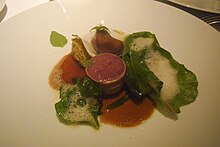


Forcemeat (derived from the French farcir, "to stuff"[1]) is a uniform mixture of lean meat with fat made by grindingorsieving the ingredients. The result may either be smooth or coarse. Forcemeats are used in the production of numerous items found in charcuterie, including quenelles, sausages, pâtés, terrines, roulades, and galantines. Forcemeats are usually produced from raw meat, except in the case of a gratin. Meats commonly used include pork, fish (pike, trout, or salmon), seafood, game meats (venison, boar, or rabbit), poultry, game birds, veal, and pork livers. Pork fatback is preferred as a fat, as it has a somewhat neutral flavor.[2][3]
Forcemeats are an ancient food and are included in Apicius,[4] a collection of Roman cookery recipes usually thought to have been compiled in the late 4th or early 5th century AD.
Often, the only binder in a forcemeat is the physical structure of the protein used. Sometimes a secondary binder is necessary to hold the mixture. These binders are generally needed when preparing country-style or gratin forcemeats. The three types of binders are eggs, dry milk powder, and panades. A panade can be made from starchy ingredients which aid in the binding process; these include well-cooked potatoes which have been puréed, cream-soaked bread, or pâte à choux.[6]